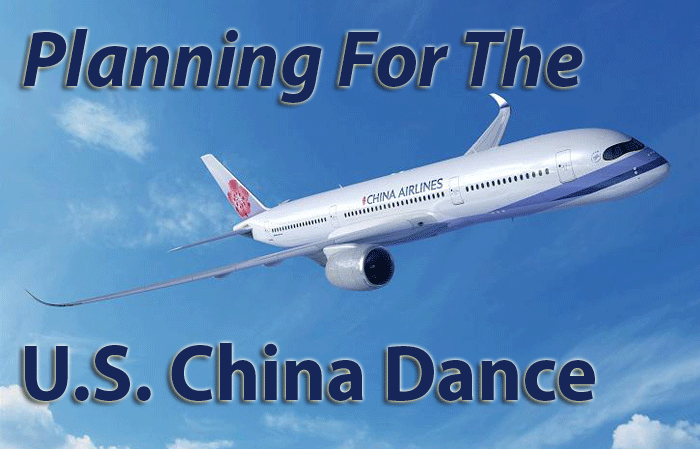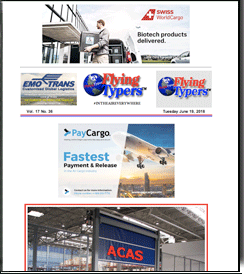
 Uncertainty
over the scale and timing of the threatened U.S.
and China trade war Uncertainty
over the scale and timing of the threatened U.S.
and China trade war
is making the forward planning of Tranpacific
freight operations increasingly complex, according
to one leading carrier.
The almost day-to-day
changes in policy pronouncements from both camps
have caused chaos for those strategizing supply
chains. And for airlines it has been little easier
than for shippers or 3PLs or caught in the cross-fire.
Taiwan
On
China Airlines told FlyingTypers that all the sabre-rattling
- alongside contrary suggestions that negotiations
to extinguish the putative Trade War might instead
yield positive results – is making it difficult
to forward plan the allocation of capacity efficiently.
“If additional
tariffs are indeed imposed this will probably
impact the amount of eastwards freight being exported
from China,” he explained.
“There have
been no significant fluctuations in demand for
air freight across regional markets due to the
trade war as yet. “China Airlines will therefore
continue to monitor closely changes in market
supply and demand in the US, China and Southeast
Asia.
Shifting
Production
“Our regional
and Transpacific capacity will be adjusted as
necessary to maintain the profitability of the
overall network.”
“However,”
he predicted that “should U.S. tariffs on
Chinese exports be imposed as threatened, then
a lot of the goods hit hardest – and the
categories of cargo targeted by the U.S. are in
the higher value range more likely to be flown
– then demand might instead shift to alternative
production centers as Chinese manufacturers simply
transfer their operations. “This could see
demand from Vietnam, for example, further spike.
“The demand
for hold space for Chinese exports to the U.S.
may shift to other Asian countries due to a transfer
of production lines as well,” he said.
Strait To The Heart
China Airlines currently
operates 14 cross-strait freight services each
week to China and is key player on the Transpacific
where 6% more freight was uplifted from the U.S.
to Asia in the first quarter than in Q1 in 2017.
Slowly
Coming Back
“For freight
from Asia to the U.S., vendor freight volumes
recovered more slowly after the Lunar New Year
period in Greater China this year so overall volume
saw little or no growth,” he added.
Asia
Still Number One
Based on IATA's
5-year forecast for global freight growth which
maintains that over 2018 - 2022 Asia-North America
and Asia-Europe lanes will generate the most freight
volume expansion, he said China Airlines was continuing
to cultivate the U.S. market and expand its North
America network.
New
Destinations
“A TPE-ONT
passenger service was launched on March 25 this
year with seven flights a week flown by B777,”
he added.
“A charter
freighter also flew for the first time to Rickenbacker
Airport (LCK) in Columbus in February this year.”
On the Asia-Europe
lane, volume growth has also been positive this
year. “China Airlines' European lanes currently
operate six freighter services a week and we are
actively studying the feasibility of adding additional
services,” he said.
“Now that
the Airbus A350-900 is in use to provide direct
flights on our European passenger routes, we will
continue to develop e-commerce express shipping,
postal shipping, fresh produce and cold-chain
cargo as well as to strengthen our cooperation
with partner airlines.
“By making
full use of the A350's belly cargo we can expand
our revenues.”
While Asia to North
America and Europe would be the main drivers of
growth, he also said the economic outlook for
Asia was favorable.
He said, this year
China Airlines plans to operate 52 freight services
on regional routes in Asia as the continued economic
growth of South East Asian countries was generating
rising volumes in the consumer electronics, textiles
and cross-border e-commerce segments.
“China Airlines
has already increased service frequency on the
TPE-SIN-PEN-TPE route twice in 2017 and intra-regional
cargo demand in Asia grew by 7.4% in 2017 compared
to the previous year,” he added.
“China Airlines
will continue to cultivate the Japan, Singapore,
Malaysia, Indonesia, Vietnam, Philippines and
Thailand markets to secure north-south cargo sources
within Asia.
“We will also
optimize our SE Asia cargo service destination
combinations and actively study the addition of
more capacity based on demand.
“We will do
all we can to support the development of SE Asia
to boost our overall business performance.”
Sea
Air Equation
“China Airlines
also remains committed to using sea-air logistics
solutions where these make sense for customers
which,” the spokesman said, “typically
occurred on lanes where there was a shortage of
free hold spaces or during peak seasons.
“Cross-strait
flying rights impose restrictions on destinations
and number of services as well,” he explained.
“For this
reason, the growth of e-commerce cargo in recent
years means there are now cargo agents that regularly
organize their own sea-air links. Goods are transported
by sea from China to Taipei then transferred to
our flights for export of e-commerce and postal
parcel sources.”
SkyKing
|




 Vol.
17 No. 36
Vol.
17 No. 36 Vol.
17 No. 37
Vol.
17 No. 37